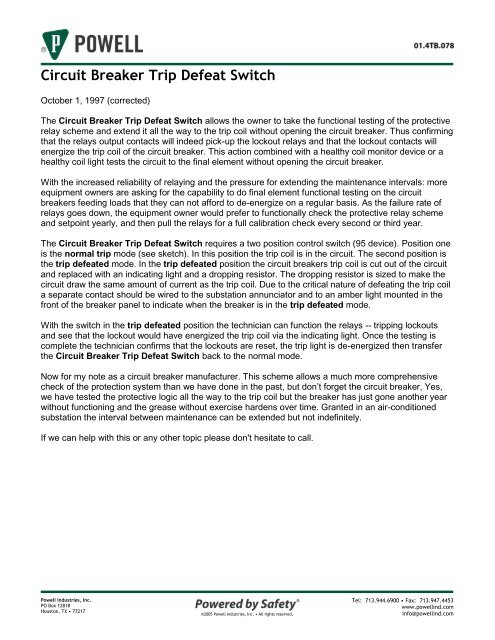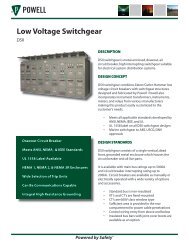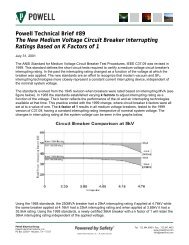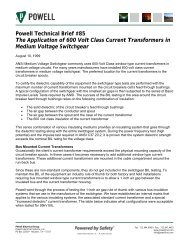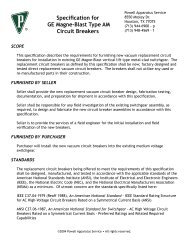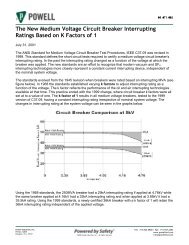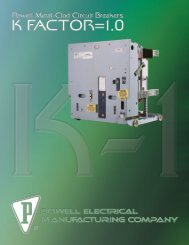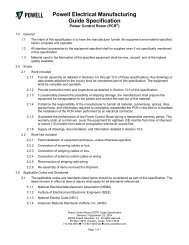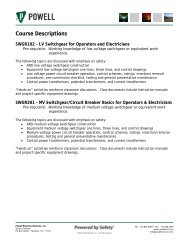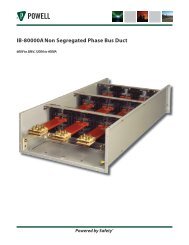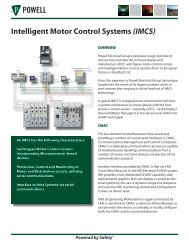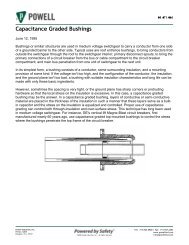Circuit Breaker Trip Defeat Switch - Powell Industries, Inc.
Circuit Breaker Trip Defeat Switch - Powell Industries, Inc.
Circuit Breaker Trip Defeat Switch - Powell Industries, Inc.
- No tags were found...
Create successful ePaper yourself
Turn your PDF publications into a flip-book with our unique Google optimized e-Paper software.
<strong>Circuit</strong> <strong>Breaker</strong> <strong>Trip</strong> <strong>Defeat</strong> <strong>Switch</strong>October 1, 1997 (corrected)The <strong>Circuit</strong> <strong>Breaker</strong> <strong>Trip</strong> <strong>Defeat</strong> <strong>Switch</strong> allows the owner to take the functional testing of the protectiverelay scheme and extend it all the way to the trip coil without opening the circuit breaker. Thus confirmingthat the relays output contacts will indeed pick-up the lockout relays and that the lockout contacts willenergize the trip coil of the circuit breaker. This action combined with a healthy coil monitor device or ahealthy coil light tests the circuit to the final element without opening the circuit breaker.With the increased reliability of relaying and the pressure for extending the maintenance intervals: moreequipment owners are asking for the capability to do final element functional testing on the circuitbreakers feeding loads that they can not afford to de-energize on a regular basis. As the failure rate ofrelays goes down, the equipment owner would prefer to functionally check the protective relay schemeand setpoint yearly, and then pull the relays for a full calibration check every second or third year.The <strong>Circuit</strong> <strong>Breaker</strong> <strong>Trip</strong> <strong>Defeat</strong> <strong>Switch</strong> requires a two position control switch (95 device). Position oneis the normal trip mode (see sketch). In this position the trip coil is in the circuit. The second position isthe trip defeated mode. In the trip defeated position the circuit breakers trip coil is cut out of the circuitand replaced with an indicating light and a dropping resistor. The dropping resistor is sized to make thecircuit draw the same amount of current as the trip coil. Due to the critical nature of defeating the trip coila separate contact should be wired to the substation annunciator and to an amber light mounted in thefront of the breaker panel to indicate when the breaker is in the trip defeated mode.With the switch in the trip defeated position the technician can function the relays -- tripping lockoutsand see that the lockout would have energized the trip coil via the indicating light. Once the testing iscomplete the technician confirms that the lockouts are reset, the trip light is de-energized then transferthe <strong>Circuit</strong> <strong>Breaker</strong> <strong>Trip</strong> <strong>Defeat</strong> <strong>Switch</strong> back to the normal mode.Now for my note as a circuit breaker manufacturer. This scheme allows a much more comprehensivecheck of the protection system than we have done in the past, but don’t forget the circuit breaker, Yes,we have tested the protective logic all the way to the trip coil but the breaker has just gone another yearwithout functioning and the grease without exercise hardens over time. Granted in an air-conditionedsubstation the interval between maintenance can be extended but not indefinitely.If we can help with this or any other topic please don't hesitate to call.<strong>Powell</strong> <strong>Industries</strong>, <strong>Inc</strong>.PO Box 12818Houston, TX • 77217©2005 <strong>Powell</strong> <strong>Industries</strong>, <strong>Inc</strong>. • All rights reserved.Tel: 713.944.6900 • Fax: 713.947.4453www.powellind.cominfo@powellind.com
<strong>Circuit</strong> <strong>Breaker</strong> <strong>Trip</strong> <strong>Defeat</strong> <strong>Switch</strong>page 2Jim BowenTechnical Director<strong>Powell</strong> <strong>Industries</strong>, <strong>Inc</strong>.PO Box 12818Houston, TX • 77217©2005 <strong>Powell</strong> <strong>Industries</strong>, <strong>Inc</strong>. • All rights reserved.Tel: 713.944.6900 • Fax: 713.947.4453www.powellind.cominfo@powellind.com


